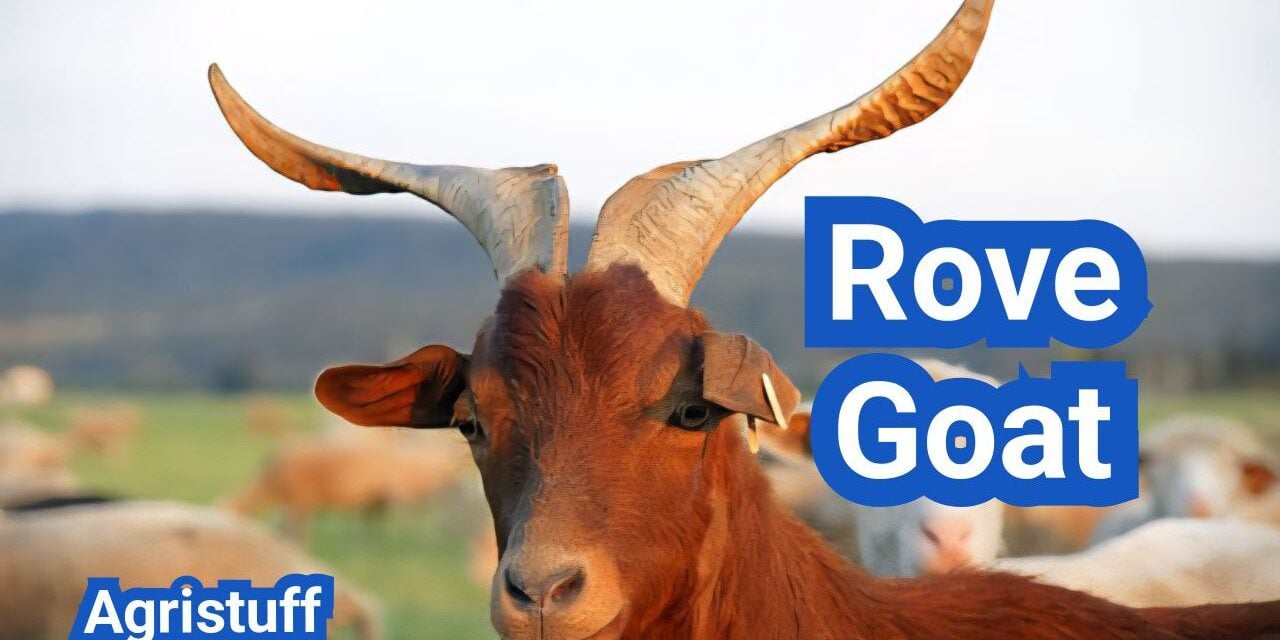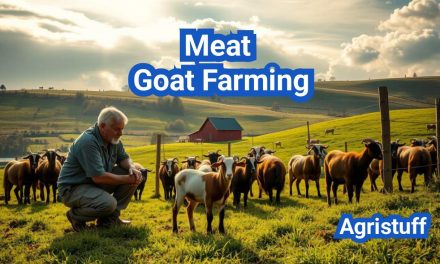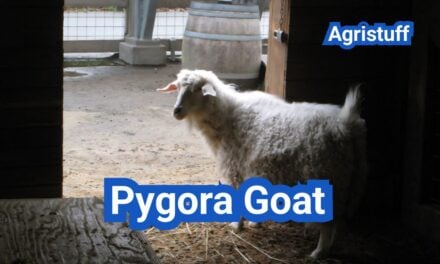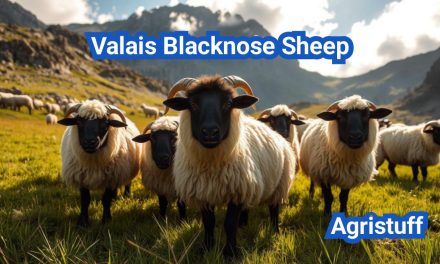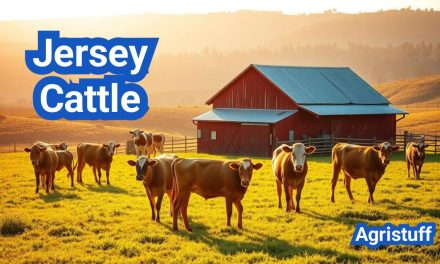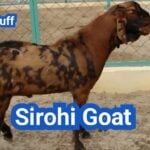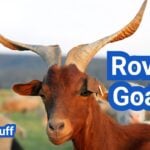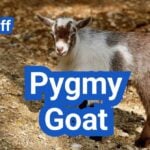The Rove Goat is a unique and fascinating breed with a rich history and diverse uses. Originating in France, this breed has been cherished for centuries for its distinctive characteristics and adaptability.
The breed is known for its large size, muscular build, and impressive lyre-shaped horns. Initially bred for meat production, the breed’s population declined significantly, leading to conservation efforts focused on milking and land management.
Today, the breed is valued for its milk, used to produce high-quality cheese and other dairy products, as well as its role in fire prevention through grazing in fire-prone areas.
Key Takeaways
- The Rove Goat is a large, antelope-type breed with lyre-shaped horns.
- Originally bred for meat, conservation efforts now focus on milking and land management.
- The breed is valued for its milk and role in fire prevention.
- Rove Goats are known for their adaptability and distinctive characteristics.
- They are used to produce high-quality cheese and dairy products.
The Rove Goat: An Overview
Originating from Southern France, the Rove Goat is an ancient breed with a multitude of uses. This breed is known for its versatility, serving purposes that range from milk production to land management.
What is a Rove Goat?
The Rove Goat is a distinctive breed characterized by its medium-to-large size and muscular build. One of its most striking features is its long, twisted lyre-shaped horns, which are not only aesthetically pleasing but also serve as a defense mechanism.
The breed’s coat varies in color, including shades of brown, black, and white, often with unique markings. Rove Goats are also known for their intelligence, curiosity, and adaptability, making them a valuable asset for farmers and herders.
Why Rove Goats Are Unique
Rove Goats stand out due to their distinctive appearance and versatile uses. Their lyre-shaped horns are a notable characteristic that distinguishes them from other breeds.
| Characteristic | Description |
|---|---|
| Size | Medium to large |
| Horns | Long, twisted, lyre-shaped |
| Coat Colors | Brown, black, white, with unique markings |
| Temperament | Intelligent, curious, adaptable |
The unique combination of physical characteristics and temperament makes the Rove Goat a valuable breed for various agricultural purposes.
History and Origin of the Rove Goat

With roots tracing back to ancient times, the Rove goat has a storied past in Southern France. The breed originated in the village of Le Rove, near Marseille, from which it derives its name. For generations, the Rove goat was valued for its meat and leather, playing a significant role in the local economy.
Ancient Origins in Southern France
The Rove goat’s history is deeply intertwined with the region of Provence, where it was bred to thrive in the local terrain. The breed’s hardiness and robustness made it an ideal choice for the rugged landscape of Southern France. Its ability to adapt to the Mediterranean climate and graze on local vegetation contributed to its popularity among local farmers.
The Rove goat’s ancient origins are a testament to its enduring qualities. Some key aspects of its history include:
- Longevity: The breed has been present in the region for centuries.
- Adaptability: Rove goats are well-suited to the Mediterranean climate.
- Economic importance: They were valued for their meat and leather, contributing to the local economy.
Domestication and Development
The domestication of the Rove goat involved selective breeding to enhance its desirable traits. Over time, farmers in Le Rove and surrounding areas developed the breed to be highly productive and resilient. By the mid-20th century, however, the breed’s population had declined significantly due to decreased interest in goat products.
Conservation efforts were initiated to protect the Rove goat, focusing on its potential for milking and land management. These efforts helped to stabilize the breed’s population and promote its unique characteristics. Today, the Rove goat is recognized for its multi-purpose utility, including milk production, meat, and land management.
Physical Characteristics of Rove Goats
Rove Goats are distinguished by their unique physical attributes, which enable them to thrive in various environments. Their robust build and distinctive features make them a notable breed among goat enthusiasts.
Size and Build
Rove Goats are characterized by their medium-to-large size and muscular build. They have strong legs that allow them to navigate challenging terrain with ease. The breed’s size and build contribute to its overall hardiness and adaptability.
Size and Weight: Adult Rove Goats typically weigh between 50 to 100 kg (110 to 220 lbs), with males being larger than females. Their sturdy build is an adaptation to their historical role in navigating rugged landscapes.
The Distinctive Lyre-Shaped Horns
One of the most striking features of the Rove Goat is its lyre-shaped horns. These horns are not only aesthetically pleasing but also serve as a defense mechanism. The lyre-shaped design is a result of the horns twisting backward and then curving upward, creating a unique and recognizable shape.
Coat Colors and Patterns
Rove Goats exhibit a variety of coat colors and patterns, adding to their visual appeal. Their coats can range from shades of brown, black, and white, often with unique markings that distinguish individual animals.
| Coat Color | Pattern | Description |
|---|---|---|
| Brown | Solid | Uniform brown color |
| Black & White | Pied | Black and white patches |
| Multi-colored | Various | Combination of brown, black, and white |
The diversity in coat colors and patterns, combined with their lyre-shaped horns and robust build, makes Rove Goats a visually striking breed. These physical characteristics not only contribute to their aesthetic appeal but also play a crucial role in their ability to thrive in diverse environments.
Rove Goat Temperament and Behavior

With their intelligent and curious nature, Rove goats exhibit a unique set of behavioral traits. Understanding these characteristics is essential for effective management and care.
Personality Traits
Rove goats are known for their independence and strong will. They are intelligent animals that require mental stimulation and physical activity to prevent boredom and stress. Their curious nature means they are always exploring their surroundings, making them engaging to watch and interact with.
These goats are also known to be playful, often displaying a lively and energetic demeanor. Their playful interactions can be a joy to observe, and they have been known to form bonds with their human caretakers.
Social Behavior
Rove goats are social creatures that thrive in the company of others. They have a hierarchical structure within their groups, with dominant goats leading the way. Understanding this social dynamic is crucial for managing a harmonious herd.
Their social behavior includes interactions not just with other goats but also with humans. They are known to be friendly and can become quite affectionate with their caretakers, making them a pleasure to work with.
To manage Rove goats effectively, it’s essential to provide them with adequate social interaction, either with other goats or through human engagement. This social interaction is vital for their emotional and psychological well-being.
How to Breed Rove Goats Successfully
Rove goat breeding is a nuanced process that demands attention to detail and a deep understanding of the breed. Successful breeding involves careful planning, from selecting the appropriate breeding stock to managing the kid rearing process.
Selecting Breeding Stock
Selecting the right breeding stock is crucial for maintaining the desirable traits of Rove goats, such as their robustness and disease resistance. Farmers should look for goats with strong physical characteristics and a healthy temperament.
Key Characteristics to Look for in Breeding Stock:
- Robust health and physical condition
- Strong lineage with proven disease resistance
- Adaptability to local climate conditions
Breeding Season and Practices
The breeding season for Rove goats typically occurs in the fall. During this time, bucks are introduced to does for natural mating. Effective breeding practices involve monitoring the health of both bucks and does to ensure successful conception.
| Breeding Practice | Description |
|---|---|
| Natural Mating | Bucks are introduced to does during the breeding season. |
| Health Monitoring | Regular checks on the health of breeding stock. |
Kid Rearing and Management
After successful breeding, the next critical phase is kid rearing and management. This involves providing proper nutrition, healthcare, and socialization to the kids to ensure their healthy development.
Nutritional Needs of Kids:
- Colostrum intake immediately after birth
- Gradual introduction to solid feed
- Access to clean water and quality forage
By focusing on these aspects, farmers can successfully breed Rove goats, maintaining the breed’s unique qualities and ensuring the health and well-being of their herd.
Milk Production and Dairy Uses

Rove goats are prized for their milk, which is not only rich in nutrients but also ideal for making cheese and other dairy products. Their milk is characterized by its high fat and protein content, making it perfect for producing high-quality dairy products.
Milk Yield and Quality
The milk yield of Rove goats is considerable, and its quality is exceptional due to its richness in fat and protein. This composition makes it particularly suitable for cheese production and other dairy applications.
Key characteristics of Rove goat milk include:
- High fat content
- Rich protein composition
- Ideal for cheese and dairy product manufacturing
Brousse du Rove: The Famous Cheese
One of the most renowned dairy products made from Rove goat milk is Brousse du Rove, a traditional cheese that is celebrated for its unique flavor and texture. This cheese is made exclusively from the milk of Rove goats and is a testament to the quality of their milk.
Brousse du Rove is not only a delight for cheese connoisseurs but also an important product for local economies where Rove goats are raised.
The production of Brousse du Rove involves traditional methods that enhance the natural qualities of the milk, resulting in a cheese that is both rich in flavor and creamy in texture.
Rove Goat Meat Production

Although not primarily raised for meat, Rove goats offer a lean and flavorful alternative. Their meat is prized in traditional Provencal cuisine for its unique taste and nutritional benefits.
Meat Quality and Characteristics
Rove goat meat is known for its lean quality and distinctive flavor. It is often described as tender and rich in protein, making it a sought-after choice for health-conscious consumers. The meat’s characteristics can be attributed to the goat’s diet and breeding practices.
| Characteristic | Description |
|---|---|
| Lean Quality | Low in fat, making it a healthier option |
| Flavor Profile | Distinctive, slightly gamey taste |
| Nutritional Value | High in protein, low in cholesterol |
Sustainable Meat Production Practices
Sustainable practices are crucial in Rove goat meat production. Farmers employ methods that ensure the environmental sustainability and social responsibility of their operations. This includes rotational grazing and organic feeding practices.
By adopting sustainable practices, farmers not only improve the quality of the meat but also contribute to the preservation of the environment and the well-being of the animals.
Land Management and Brush Clearing Benefits
Rove goats are instrumental in maintaining land health through their grazing. Their presence is particularly valuable in areas prone to wildfires, where they help clear brush and reduce combustible vegetation.
Grazing Habits and Patterns
The grazing habits of Rove goats are characterized by their ability to navigate difficult terrain, making them ideal for land management in rugged areas. Their browsing behavior helps control vegetation growth, preventing the accumulation of dry underbrush that can fuel wildfires.
“Rove goats are known to graze on a wide variety of vegetation, including shrubs and small trees, which helps maintain open spaces and promotes biodiversity.” This diverse grazing pattern is crucial for maintaining ecosystem balance and supporting other wildlife.
Fire Prevention Applications
One of the significant benefits of using Rove goats for land management is their role in fire prevention. By clearing brush and reducing fuel loads, they help mitigate the risk of catastrophic wildfires. This approach is both cost-effective and environmentally friendly, as it eliminates the need for mechanical clearing or chemical treatments.
- Reduces fuel loads in fire-prone areas
- Creates fire breaks through grazing
- Promotes ecosystem health
Environmental Impact
The environmental impact of using Rove goats for land management is generally positive. Their grazing activities promote biodiversity by creating a mosaic of different habitats. This diversity supports a wide range of plant and animal species, enhancing ecosystem resilience.
As noted by the Association De Defense Des Carprins Du Rove,
“The Rove goat is a valuable tool for maintaining the health and biodiversity of Mediterranean ecosystems.”
This highlights the importance of preserving and promoting the use of Rove goats in land management practices.
How to Raise Rove Goats in the USA

The process of raising Rove goats in the USA involves several key steps, starting with acquisition. For farmers interested in this unique breed, understanding the intricacies of Rove goat care is crucial for successful integration into American farming practices.
Acquiring Rove Goats in America
Acquiring Rove goats in the United States can be challenging due to their rarity outside of France. Farmers have two primary options: importing directly from France or finding a local breeder who specializes in Rove goats. Importing can be complex, involving regulations related to animal health and quarantine. “Importing Rove goats requires meticulous planning and compliance with USDA regulations,” notes an expert in goat farming.
Finding a local breeder is often the more straightforward route, although it may limit the genetic diversity of the herd. Local breeders can provide valuable insights into the breed’s characteristics and help new farmers avoid common pitfalls.
Adaptation to American Climates
Rove goats are known for their hardiness and adaptability, traits that have been honed through centuries in the harsh Mediterranean climate. However, adapting to American climates, which can range from humid and hot to cold and snowy, requires careful management.
Climate Considerations: In regions with extreme temperatures, providing adequate shelter is essential. Goats need protection from wind, rain, and direct sunlight. In colder climates, ensuring that shelters are well-insulated and draft-free is crucial for maintaining the health of the goats.
“The ability of Rove goats to thrive in various climates makes them an attractive option for diverse farming operations in the USA.”
In hotter climates, ensuring access to shade and adequate ventilation is vital. Farmers should also be aware of the potential for heat stress and take preventive measures, such as providing cool water and ensuring that the goats have sufficient space to move around.
By understanding the specific needs of Rove goats and taking steps to adapt their care to local conditions, American farmers can successfully raise this unique and versatile breed.
Housing and Shelter Requirements

To keep your Rove Goats healthy, appropriate housing is essential. Providing the right shelter and living conditions is crucial for their overall well-being and productivity.
Shelter Design and Construction
The shelter for your Rove Goats should be designed to protect them from extreme weather conditions such as heat, cold, and rain. A well-ventilated shelter is vital to prevent the buildup of moisture and reduce the risk of respiratory issues. The construction materials should be durable and able to withstand various weather conditions.
Key considerations for shelter design include:
- Adequate ventilation to maintain air quality
- Protection from wind, rain, and direct sunlight
- Dry bedding to keep the goats comfortable
Space and Fencing Requirements
Rove Goats need ample space to roam and graze. The enclosure should be spacious enough to accommodate their natural behavior, including climbing and playing. Fencing is a critical aspect of their housing, as it needs to be secure to prevent escape and protect the goats from predators.
When planning the space and fencing, consider the following:
- Provide at least 10 square feet per goat inside the shelter
- Ensure the fencing is at least 5 feet high to prevent jumping
- Use sturdy materials for fencing to withstand the goats’ attempts to escape
Ensuring that your Rove Goats have access to fresh water at all times is also crucial. Proper housing and shelter are foundational to their health and productivity.
Feeding and Nutrition Guide for Rove Goats

Understanding the nutritional needs of Rove Goats is crucial for their overall health and productivity. Rove goats thrive on high-quality forage, including a mix of grasses, legumes, and browse. Ensuring they have access to fresh water at all times is vital for their hydration.
Daily Dietary Needs
Rove goats require a diet rich in nutrients to maintain their health and support their productivity. Their daily dietary needs include:
- High-quality forage such as grasses and legumes
- Adequate browse to support their natural grazing behavior
- Minerals and vitamins to supplement their diet
Nutritional Requirements can be met by providing a varied diet that includes a mix of hay, grains, and fresh forage. It’s essential to ensure that the diet is well-balanced to prevent nutritional deficiencies.
Seasonal Feeding Adjustments
Seasonal changes can affect the quality and availability of forage, necessitating adjustments to their diet. For example, during winter months when fresh forage is scarce, hay and grains can be used as supplements.
| Season | Dietary Adjustments |
|---|---|
| Spring | Increase fresh forage |
| Winter | Supplement with hay and grains |
Water Requirements
Access to fresh, clean water is essential for Rove goats at all times. Hydration is critical for their overall health and productivity. Ensuring that water sources are clean and readily available is a key aspect of their nutritional care.
“Adequate hydration is as important as a balanced diet for maintaining the health of Rove goats.”
By focusing on these nutritional aspects, Rove goat farmers can ensure the health and productivity of their animals.
Health Management for Rove Goats

To keep Rove Goats healthy, a comprehensive health management plan is essential. This involves regular monitoring and maintenance to prevent health issues.
Common Health Issues and Prevention
Rove Goats are generally hardy animals, but they can be susceptible to certain health issues if not properly cared for. Regular health check-ups are crucial to identify any potential problems early on.
Common health issues in Rove Goats include:
- Parasitic infections
- Respiratory diseases
- Nutritional deficiencies
Preventing these issues involves maintaining a clean and dry living environment, providing a balanced diet rich in fiber, vitamins, and minerals, and implementing a regular vaccination schedule.
Parasite Control Methods
Parasite control is a critical component of Rove Goat health management. Effective methods include:
- Regular fecal exams to monitor parasite loads
- Strategic deworming programs tailored to the farm’s specific needs
- Pasture management techniques such as rotational grazing
| Method | Description | Benefits |
|---|---|---|
| Fecal Exams | Regular monitoring of parasite loads | Early detection of parasite issues |
| Strategic Deworming | Targeted deworming based on parasite load | Reduced risk of resistance, effective control |
| Rotational Grazing | Grazing animals on different pastures to reduce parasite load | Decreased parasite burden, improved pasture health |
Preventative Care Routine
A preventative care routine is vital for maintaining the health of Rove Goats. This includes:
- Regular vaccinations against common diseases
- Monitoring for signs of illness or stress
- Providing a nutritious diet and clean water
By implementing these health management strategies, farmers can help ensure the well-being and productivity of their Rove Goat herds.
Unique Facts About the Rove Goat

With a history dating back centuries, the Rove goat has several intriguing facts associated with it. This breed, known for its impressive lyre-shaped horns, has been a part of the southern French landscape for a long time.
Interesting Facts and Trivia
The Rove goat is not just any ordinary goat breed; it has several unique characteristics. One of the most striking features is its large, lyre-shaped horns, which are not only aesthetically pleasing but also serve as a defense mechanism. These goats are also known for their agility and ability to navigate challenging terrains.
Historically, Rove goats were bred primarily for their meat. However, their milk is also used to produce the famous Brousse du Rove cheese, highlighting their multi-purpose utility.
Comparison to Other Mediterranean Breeds
When comparing the Rove goat to other Mediterranean breeds, several differences become apparent. The size and shape of their horns are particularly distinctive, setting them apart from other breeds like the Maltese or the Greek goat.
Another significant aspect is their adaptability to the Mediterranean climate, which is characterized by hot summers and mild winters. Rove goats have shown resilience in such conditions, making them suitable for regions with similar climatic profiles.
In conclusion, the Rove goat stands out due to its unique physical characteristics, historical significance, and adaptability. Understanding these unique facts can help appreciate the breed’s value and the need for its conservation.
Economic Value of Rove Goats for Small Farms
The economic value of Rove goats lies in their versatility, providing milk, meat, and land management services. This multi-faceted utility makes them an attractive option for small farms looking to diversify their products and enhance their sustainability.
Multi-Purpose Benefits
Rove goats offer several benefits that contribute to their economic value. Their milk is used to produce high-quality dairy products, such as the renowned Brousse du Rove cheese. The meat from Rove goats is also valued for its quality and is consumed locally. Additionally, their grazing habits make them ideal for land management, helping to clear brush and prevent wildfires.
Land management is a critical service provided by Rove goats. By grazing on unwanted vegetation, they help maintain open spaces and reduce the risk of wildfires, which can be a significant threat to rural areas. This service not only benefits the farm but also contributes to the overall health of the local ecosystem.
Marketing Rove Goat Products
Effective marketing is crucial to capitalize on the economic value of Rove goats. Farmers can market their products through various channels, including local farmers’ markets, specialty food stores, and online platforms. Highlighting the unique characteristics of Rove goat products, such as their sustainable production methods and high quality, can help attract consumers willing to pay a premium for artisanal products.
Storytelling can also be a powerful marketing tool. By sharing the history and cultural significance of Rove goats, as well as the care and dedication that goes into raising them, farmers can create an emotional connection with potential customers, enhancing the appeal of their products.
To further enhance the marketability of Rove goat products, farmers can consider obtaining certifications that recognize the unique qualities of their products. This can include organic or artisanal certifications that appeal to consumers looking for high-quality, sustainably produced goods.
Conservation Status and Preservation Efforts
The conservation status of the Rove goat is a pressing concern that necessitates immediate attention and action. As a breed with a rich history and unique characteristics, the Rove goat’s decline in population has raised alarms among conservationists and breeders alike.
Current Population Status
The Rove goat’s population has faced significant challenges, particularly in the 1970s when it was on the brink of extinction. Conservation efforts have been instrumental in stabilizing its numbers, but continued vigilance is necessary to ensure the breed’s survival.
According to recent data, the breed is protected by the Association De Defense Des Carprins Du Rove in France, which has played a crucial role in its preservation. The association’s efforts include breeding programs, genetic conservation, and promoting the breed’s unique qualities.
Preservation Initiatives
Several preservation initiatives are underway to safeguard the Rove goat’s future. These include:
- Breeding programs aimed at increasing the population and maintaining genetic diversity.
- Educational campaigns to raise awareness about the breed’s significance and the challenges it faces.
- Support for farmers and breeders who are committed to raising Rove goats, providing them with resources and guidance.
These efforts are crucial not only for the survival of the Rove goat but also for the preservation of its unique genetic heritage and the cultural practices associated with it. By supporting conservation initiatives, we can ensure that this remarkable breed continues to thrive for generations to come.
Is the Rove Goat Right for Your Farm?
Raising Rove goats can be a rewarding endeavor for those with a passion for sustainable farming and animal husbandry. As you’ve learned, Rove goats offer a multitude of benefits, from their unique history and characteristics to their versatility in milk, meat, and land management.
When considering whether the Rove goat is right for your farm, it’s essential to evaluate your farm’s specific needs and resources. Factors such as climate, available land, and market demand for Rove goat products should be taken into account.
If you’re looking for a hardy, adaptable breed that can thrive in challenging environments, the Rove goat may be an excellent choice. With proper care and management, Rove goats can provide a valuable source of income and contribute to a sustainable farming operation.
In conclusion, the Rove goat is a unique and valuable breed that can offer numerous benefits to farmers who are willing to invest in their care and management. Is the Rove goat right for your farm? By carefully considering your farm’s needs and resources, you can make an informed decision and potentially discover a new opportunity for sustainable farming success.
FAQ
What is a Rove Goat?
The Rove Goat is a unique and fascinating breed originating from Southern France, known for its large size, muscular build, and impressive lyre-shaped horns.
What are the primary uses of Rove Goats?
Rove Goats are valued for their milk, used to produce high-quality cheese and other dairy products, as well as their role in fire prevention through grazing in fire-prone areas, and they also provide a source of lean and flavorful meat.
What makes Rove Goat milk unique?
Rove Goat milk is rich in fat and protein, making it ideal for producing a variety of dairy products, particularly cheese, such as Brousse du Rove, which is celebrated for its unique flavor and texture.
How do Rove Goats contribute to land management?
Rove Goats play a significant role in land management through their grazing habits, which help in clearing brush and vegetation in areas that are difficult to access, reducing the risk of wildfires.
What are the benefits of raising Rove Goats?
Raising Rove Goats offers several benefits, including their multi-purpose utility, providing milk, meat, and contributing to land management, as well as their potential for sustainable and environmentally friendly production practices.
Are Rove Goats dairy goats?
Yes, Rove Goats are dairy goats, and their milk is used to produce high-quality dairy products, although they are not exclusively raised for dairy purposes.
What is the average milk production of Rove Goats?
While the exact average milk production can vary, Rove Goats are known for their high-quality milk, which is rich in fat and protein, making it suitable for cheese production.
How do I acquire Rove Goats in the USA?
Acquiring Rove Goats in the USA involves either importing them or finding a domestic breeder, and it’s essential to research and understand the specific needs and regulations involved.
What are the housing and shelter requirements for Rove Goats?
Rove Goats require appropriate housing and shelter that protects them from extreme weather conditions, with adequate space to roam and graze, and secure fencing to prevent escape and predation.
What are the nutritional needs of Rove Goats?
Rove Goats require a diet centered around high-quality forage, including grasses, legumes, and browse, with access to fresh water at all times, and may need seasonal adjustments and supplementation with minerals and vitamins.
How do I manage the health of my Rove Goats?
Effective health management for Rove Goats involves regular check-ups, maintaining a clean and dry living environment, a balanced diet, parasite control measures, and a preventative care routine.
Conclusion of: Rove Goat Bree
Introduction to the Rove Goat
The Rove Goat is a distinctive Mediterranean goat breed that originated in southern France and is now admired worldwide for its dramatic spiral horns, rich milk, and ability to thrive on rough, dry terrain. For small farms, homesteads, and artisan producers in the United States, the Rove Goat can be an exciting heritage option because it combines historical value with practical performance in meat, milk, and landscape management.
As consumers look for unique stories behind their food, the Rove Goat offers powerful branding potential built on tradition, terroir, and sustainable grazing. Understanding the background, traits, and management needs of the Rove Goat is the first step in deciding whether this breed fits your agricultural plans. Overview of the Rove Goat breed
History and Origin of the Rove Goat
The history of the Rove Goat is closely tied to the rugged hills and scrubland around the village of Le Rove near Marseille, where the breed developed over centuries as a companion to nomadic shepherds. According to local tradition, the ancestors of the Rove Goat may have reached Provence along ancient Mediterranean trade routes from regions such as Greece, Anatolia, or the Middle East, and then adapted to the limestone hills and garrigue vegetation of southern France.
For generations, the Rove Goat supplied milk, meat, and skins to rural families while traveling long distances on seasonal migrations. Today, the Rove Goat remains part of the cultural identity of Provence and is recognized as an important genetic and gastronomic heritage resource. Slow Food history of the Rove Goat
Geographic Distribution and Conservation of the Rove Goat
Although the Rove Goat is known internationally among rare-breed enthusiasts, its core population remains concentrated in southeastern France, especially in the departments around Marseille and the wider Provence region. Most Rove Goat herds still graze rocky hills and scrubby pastures where their browsing habits help keep vegetation in check and support fire prevention strategies.
The breed came close to disappearing in the twentieth century as extensive grazing systems declined and other goats replaced the Rove Goat. However, organized breeders, conservation groups, and the growing popularity of traditional cheeses have helped the Rove Goat recover. Today, the Rove Goat is considered locally secure but numerically limited, so maintaining genetic diversity and responsible breeding remains a priority. Rove Goat breed factsheet (Capgènes)
Physical Characteristics of the Rove Goat
The Rove Goat is instantly recognizable thanks to its spectacular horns, which form long, twisted arcs that can reach impressive lengths in mature animals. These horns give the Rove Goat a striking silhouette and are often a key attraction for visitors and customers. The breed typically has a strong, muscular body, deep chest, and sturdy limbs that are well suited to climbing and navigating rocky slopes.
Coat colors in the Rove Goat vary and may include red, brown, black, ash-gray, or mottled shades, sometimes with lighter markings on the underside and legs. Adult Rove Goat does are of medium size, while bucks are larger and heavier, giving the breed ample frame for meat production as well as a robust presence in the pasture. Morphological description of the Rove Goat
Temperament and Adaptation of the Rove Goat
The Rove Goat has been shaped by centuries of life in harsh Mediterranean conditions, which gives the breed a reputation for hardiness, agility, and independence. On rough rangeland, the Rove Goat actively seeks shrubs, tree shoots, and coarse plants that many other animals avoid, making it a powerful browsing and brush-control tool.
At the same time, many herders describe the Rove Goat as intelligent, alert, and capable of forming strong bonds with people when handled calmly and consistently. Like most goats, the Rove Goat prefers to live in social groups and follows established routes and routines. Its adaptability to heat, drought, and low-quality forage makes the Rove Goat attractive for low-input systems and fire-prone landscapes where grazing can provide ecological services. Production and adaptation traits of the Rove Goat
Rove Goat as a Dual-Purpose Meat and Dairy Breed
Traditionally, the Rove Goat was raised primarily as a meat animal, producing flavorful carcasses from kids and cull adults that grazed marginal lands. Over time, farmers also recognized the strong dairy potential of the Rove Goat, which produces milk with high levels of butterfat and solids well suited to artisan cheese. Although a Rove Goat doe generally yields less milk than specialized dairy breeds such as Saanen or Alpine, the dense, aromatic milk is valued for quality rather than sheer volume.
This makes the Rove Goat an interesting option for farmers who want a dual-purpose goat that contributes both meat and milk within small, diversified operations. In many modern systems, the Rove Goat’s flexibility as a dual-purpose breed is a key reason to consider it over highly specialized goats. Rove Goat meat and dairy performance
Cheeses Made from Rove Goat Milk
One of the main reasons the Rove Goat has attracted culinary attention is the famous cheese Brousse du Rove, a small, fresh lactic cheese made traditionally from the raw milk of free-grazing Rove Goat herds near Marseille. This cheese has earned a protected designation and is produced by only a handful of farms that respect strict grazing and milk-handling rules.
The rich milk of the Rove Goat yields a delicate, tangy curd with complex herbal aromas that reflect the Mediterranean plants the goats browse. Beyond Brousse du Rove, some producers create other artisan cheeses that feature or blend Rove Goat milk, showcasing how this breed can support high-value specialty dairy niches. For American cheesemakers, the story of the Rove Goat and its iconic cheese can inspire similar, terroir-driven products. Brousse du Rove goat cheese profile
The Role of the Rove Goat in Mediterranean Landscapes
In its home region, the Rove Goat is not just a farm animal but an active partner in landscape management. Large flocks of sheep and Rove Goat herds have long moved seasonally between lowland and upland pastures, shaping vegetation patterns and keeping woody plants under control. This grazing behavior from the Rove Goat helps reduce the fuel load for wildfires, maintain open scrubland habitats, and preserve scenic views that are important for rural tourism.
Modern land managers increasingly look to the Rove Goat as part of targeted grazing projects designed to manage invasive species, shrubs, and fire-sensitive vegetation. By using the Rove Goat instead of heavy machinery or herbicides, these systems can support biodiversity, soil health, and carbon storage while maintaining traditional pastoral practices. Rove Goat in conservation and landscape use
Prospects for the Rove Goat on U.S. Farms
For producers in the United States, the Rove Goat is still relatively rare, and purebred breeding stock may require importation or collaboration with specialized breeders. However, the breed’s unique qualities make the Rove Goat appealing for niche markets, such as farmstead cheese, heritage meat, agritourism, and ecological grazing services. A U.S. farm that raises the Rove Goat can differentiate its products by highlighting the breed’s Mediterranean origin, traditional cheeses, and role in fire prevention.
Some farmers might introduce Rove Goat genetics through crossbreeding to enhance browsing ability and milk richness in existing herds. Before investing, it is essential to research import rules, demand in local markets, and the long-term economics of maintaining a small, high-value Rove Goat herd in the American context. Breed comparison including the Rove Goat
Housing and Facilities for the Rove Goat
The Rove Goat needs secure, practical housing much like other goat breeds, but its large horns and active nature require extra attention to space and design. A simple three-sided shed or open-front barn that keeps the Rove Goat dry, shaded, and protected from wind is usually sufficient in mild climates, as long as bedding stays clean and flooring is well drained. Feeders, head gates, and doorways must be wide enough and free of protrusions so the Rove Goat does not get its horns caught.
Good ventilation without direct drafts, plus separate areas for kidding and quarantine, help maintain health and reduce stress. When planning facilities for the Rove Goat, think about how animals will move through alleys and pens and how you will safely handle them for hoof trimming, milking, or veterinary work. Goat housing and facility design guidance
Feeding and Nutrition for the Rove Goat
In extensive systems, the Rove Goat obtains much of its diet from browsing shrubs, tree leaves, and other woody plants, but even in such settings it is important to monitor body condition and provide supplementation when needed. On more intensive U.S. farms, the Rove Goat will usually rely on a combination of pasture, hay, and sometimes small amounts of grain or concentrate, especially in late gestation and early lactation.
A mature Rove Goat doe typically needs enough energy and protein to support maintenance, fetal growth, and milk production, while bucks and growing kids have their own requirements based on age and activity. Free-choice access to clean water and a balanced mineral mix formulated for goats is crucial. With smart pasture rotation and forage planning, the Rove Goat can turn low-cost feed resources into high-value products. Nutritional guidelines for meat and dual-purpose goats
Breeding and Reproduction in the Rove Goat
Like other temperate goat breeds, the Rove Goat is usually a seasonal breeder, with does cycling in the fall and kidding primarily in late winter or spring. The average gestation period for a Rove Goat pregnancy is around 150 days, and most does give birth to single or twin kids, though higher litter sizes are possible in well-managed herds.
Good reproductive performance in the Rove Goat depends on sound genetics, proper nutrition, parasite control, and low stress during breeding and kidding. Farmers interested in improving their Rove Goat herd should keep records of kidding dates, kid survival, growth rates, and milk yield so that they can select the most productive and resilient animals. Over time, careful selection strengthens the Rove Goat’s value as both a productive and heritage breed. Breeding and management of the Rove Goat
Health, Parasites, and Preventive Care for the Rove Goat
Even though the Rove Goat is hardy and adapted to harsh conditions, it still requires a proactive health program to perform well in modern production systems. Internal parasites, especially gastrointestinal worms, can affect the Rove Goat just as they do other goats, reducing weight gains and milk yield if not controlled.
Current best practices emphasize targeted treatment based on FAMACHA scoring, fecal egg counts, and overall condition rather than routine blanket deworming, which can lead to resistance. Vaccination against common clostridial diseases, regular hoof trimming, and monitoring for external parasites such as lice and mites are also important for keeping the Rove Goat healthy. Working with a veterinarian who understands goats will help tailor a preventive care plan appropriate for your climate and management style. Sustainable parasite control for goats
Handling, Behavior, and Welfare of the Rove Goat
The impressive horns and active demeanor of the Rove Goat mean that calm, confident handling is especially important for safety and welfare. When young, the Rove Goat benefits from frequent gentle interaction so that it learns to accept being touched, haltered, and led. Well-designed handling facilities with solid sides, non-slip flooring, and wide gates help guide the Rove Goat while minimizing stress and the risk of injury.
Because goats are social, a Rove Goat should not be kept alone, and adequate space, shelter, and enrichment can reduce aggression within the group. Observing daily behavior and quickly addressing signs of lameness, illness, or conflict will support good welfare and productivity. Over time, a well-managed Rove Goat herd can become easy to work with and a strong ambassador for your farm. Goat handling and welfare resources
Economic Uses and Niche Markets for the Rove Goat
From an economic standpoint, the Rove Goat offers several potential revenue streams that can be combined in creative ways. Meat from Rove Goat kids and surplus adults can be marketed as a specialty product highlighting grass-based or brush-based feeding systems. Rove Goat milk can be transformed into fresh or aged cheeses with strong regional storytelling that appeals to farm visitors, local restaurants, and specialty shops.
In addition, the browsing abilities of the Rove Goat can be sold as a service through targeted grazing contracts for firebreaks or weed control. For direct-marketing farms and agritourism operations, the dramatic appearance and compelling history of the Rove Goat can attract customers, photographers, and educational groups, adding value beyond direct products. Example of farmstead cheeses using Rove Goat milk
Getting Started with the Rove Goat: Practical Steps
Anyone considering the Rove Goat should start with a clear plan that matches the breed’s strengths with specific farm goals. Begin by deciding whether your main focus with the Rove Goat will be milk, meat, brush control, agritourism, or a combination of these. Then assess your land base, climate, forage resources, housing, and labor capacity to determine how many Rove Goat animals you can realistically manage.
Because the breed is rare, it is essential to research reputable sources of breeding stock and understand any import or transport regulations if animals must come from abroad. As you establish your Rove Goat herd, work closely with extension agents and veterinarians, keep detailed records, and adjust your strategy based on performance and market feedback. With careful planning, the Rove Goat can be a rewarding long-term investment. Planning and starting a goat operation
Final thought
The Rove Goat brings together history, resilience, and modern niche opportunity in a way that few livestock breeds can match. From the scrub-covered hills of Provence to potential roles on American farms, the Rove Goat demonstrates how a traditional breed can still provide value in today’s agriculture through dual-purpose production, artisan foods, and ecological services. For farmers who enjoy storytelling, careful stewardship, and differentiated products, the Rove Goat offers more than milk and meat; it offers a living link to culture and landscape. By honoring the breed’s origins, applying sound management, and connecting with consumers who appreciate authenticity, the Rove Goat can become a centerpiece of a sustainable and profitable farm enterprise. Heritage significance of the Rove Goat
Sources & References
The following trusted resources provide deeper technical, historical, and practical information for producers, researchers, and enthusiasts who want to learn more about the Rove Goat and related goat management topics. Referring to these sources can help you validate facts, design your Rove Goat system, and stay current with best practices in small ruminant production.
- Rove Goat – breed overview (Wikipedia)
- Rove Goat breed factsheet – Capgènes (France)
- The Rove goat: provider of milk and meat – CABI article
- Conservation of local goat breeds in southern France – Rove Goat case study
- Slow Food Ark of Taste – Rove Goat
- Slow Food Presidia – Brousse du Rove goat cheese
- Rove de Garrigues – Culture Cheese Magazine profile
- Farmstead cheeses from Rove Goat milk – Domaine Les Pallières
- Housing & facilities for dairy goats – Alabama Extension
- Meat goat management and nutrition – Mississippi State Extension
- Sustainable parasite control for sheep and goats – Mississippi State Extension
- Small ruminant technical information – NC State Extension
- Establishing a meat goat operation – goats.extension.org
- Types of goat breeds, including the Rove Goat – Reformation Acres
- Rove Goat management practices – GoatFarming.in

